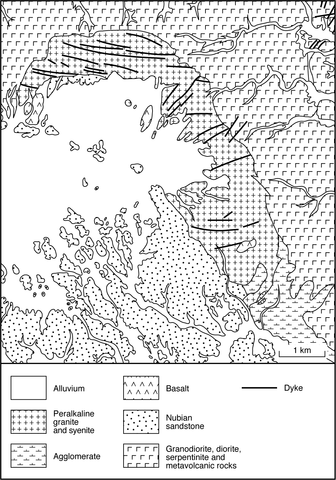stripes
A curving 8 km long ridge may represent the eastern half of a ring, the western part of which is obscured by volcanic rocks, Nubian sandstone, which is in places metamorphosed, and wadi alluvium. There are remnants of a volcanic cone, overlying Nubian sandstone, to the southeast of the ridge and basalt lavas lie on the inner side of the ridge in the northwest and northeast. The ridge is composed of peralkaline granites and syenites that are generally in contact with Precambrian serpentinite and metavolcanic rocks. Many contacts are sheared and faulted. The ridge syenites contain 5-10% quartz and up to 5% of sodic amphibole, biotite and opaque minerals. The granites contain 5-15% of aegirine, a little riebeckitic amphibole and altered biotite. Dykes of peralkaline quartz syenite, granite and felsite are widespread. Rock analyses are given in El Ramly et al. (1971) and Abdel-Karim et al. (1997), and there are data for U and Th from eight rocks in El Reedy (1985).
ABDEL-KARIM, A.M., AZZAZ, S.A. and ABDEL-GAWAD, G.M. 1997. Petrography and geochemistry of the basement rocks of Zargat Na’Am-Hagar El-Fil area, South Eastern Desert, Egypt. Annals of the Geological Survey of Egypt, 20: 281-308. EL RAMLY, M.F., BUDANOV, V.I. and HUSSEIN, A.A.A. 1971. The alkaline rocks of south-eastern Egypt. Geological Survey of Egypt, Paper, 53: 1-111.El Reedy, 1985; HASHAD, A.H. and EL REEDY, M.W.M. 1979. Geochronology of the anorogenic alkalic rocks, South Eastern desert, Egypt. Annals of the Geological Survey of Egypt, 9: 81-101.OMAR, G.I., KOHN, B.P., LUTZ, T.M. and FAUL, H. 1987. The cooling history of Silurian to Cretaceous alkaline ring complexes, South Eastern Desert, Egypt, as revealed by fission-track analysis. Earth and Planetary Science Letters, 83: 94-108.SERENCSITS, C.M., FAUL, H., FOLAND, K.A., EL RAMLY, M.F. and HUSSEIN, A.A. 1979. Alkaline ring complexes in Egypt: their ages and relationship to tectonic development of the Red Sea. Annals of the Geological Survey of Egypt, 9: 102-16.

